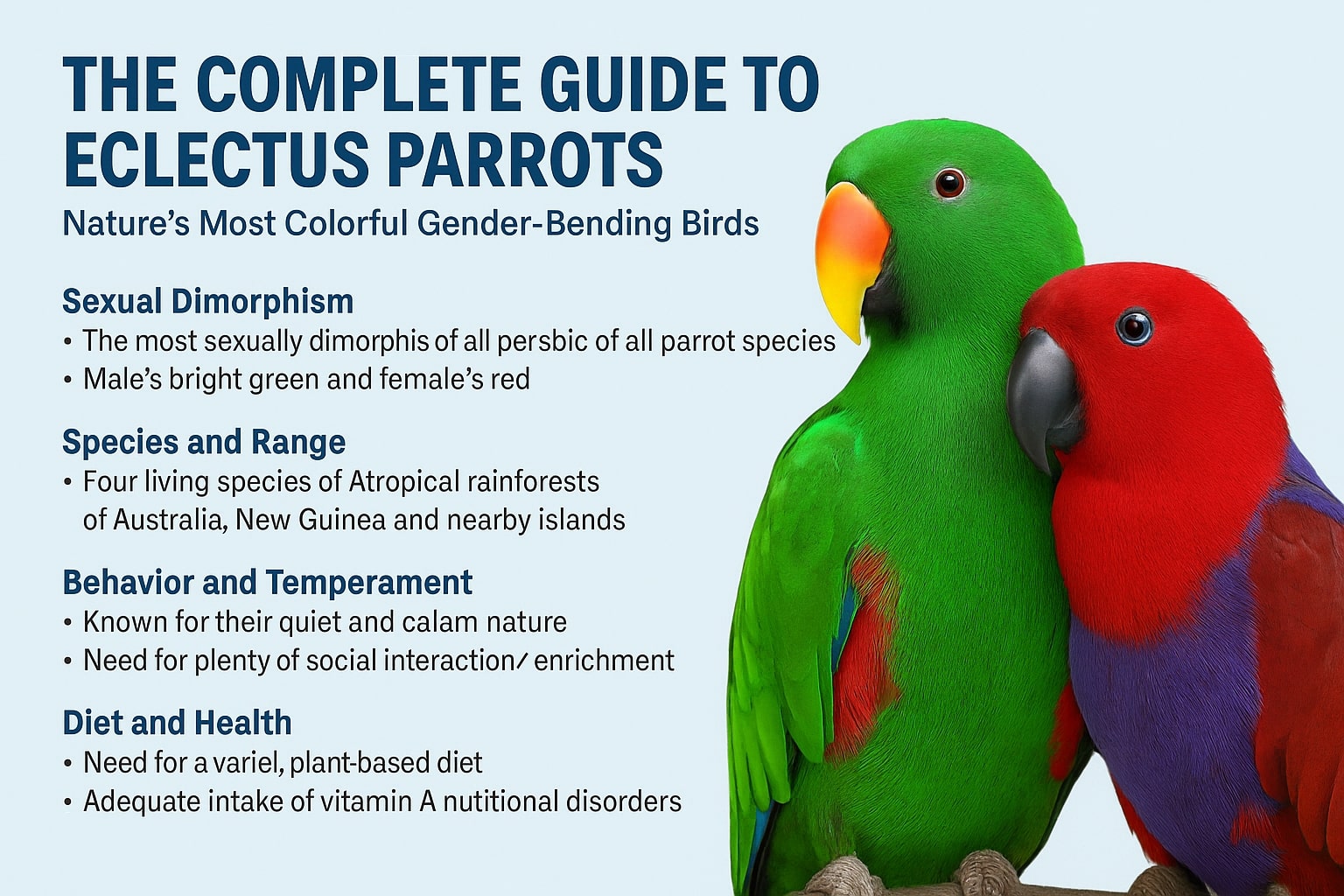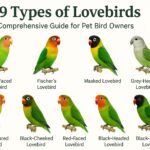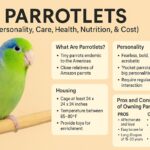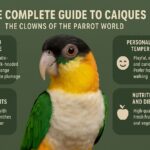Eclectus parrots represent one of the most fascinating examples of sexual dimorphism in the avian world, with males and females so different in appearance that scientists once believed they were entirely separate species.
These remarkable birds from the tropical regions of Australia, New Guinea, and surrounding islands have captured the hearts of bird enthusiasts worldwide with their striking colors, gentle temperament, and unique biological characteristics.
For decades, their extreme color differences puzzled researchers until the early 20th century when the connection between the brilliant green males and vivid red females was finally established, revolutionizing our understanding of these extraordinary creatures.
Physical Characteristics and the Marvel of Sexual Dimorphism
The most striking feature of eclectus parrots is their pronounced sexual dimorphism, making them the most sexually dimorphic of all parrot species1. This remarkable difference in appearance between males and females is so extreme that it defies typical patterns seen in most bird species.
Male eclectus parrots display brilliant emerald green plumage with bright red underwings, blue primaries, and a distinctive yellow to orange beak.
Their coloration is so vibrant that they appear almost jewel-like in bright sunlight, with the green feathers showing subtle variations in tone across different body regions.
Female eclectus parrots present an entirely different appearance, sporting deep red and purple plumage with royal blue underparts and a solid black beak.
The intensity of their red coloration varies among subspecies, with some displaying brighter reds while others show more purple tones. This dramatic color difference represents what scientists call “reverse sexual dichromatism,” where females are more brightly colored than males, which is unusual in the bird world.
These medium-sized parrots typically measure between 35-42 cm (14-17 inches) in length, with some sources indicating they can reach up to 20 inches (50 cm). They possess characteristically large heads and relatively short tails compared to other parrot species, giving them a stocky, robust appearance. Both sexes share similar size ranges, though individual birds may vary considerably within these parameters.
Interestingly, despite this extreme visual dimorphism, eclectus parrots do not exhibit the behavioral role reversal that often accompanies such dramatic physical differences in other bird species.
Unlike many birds, where bright female coloration correlates with females taking dominant roles in territory defense and courtship while males handle nesting duties, both sexes in eclectus parrots maintain traditional roles with males foraging and females incubating eggs.
Species Classification and Geographic Distribution
The genus Eclectus, first described by Johann Georg Wagler in 1832, currently includes four recognized living species and one extinct species. The name derives from the ancient Greek and Latin term “eklektos,” meaning “chosen one,” reflecting the special status these birds held among early researchers.
Each species has adapted to specific island environments across the Indo-Pacific region, creating distinct populations with subtle variations in size, coloration, and behavior.
The Moluccan eclectus (Eclectus roratus) represents the most widespread species, native to the Maluku Islands, with three recognized subspecies. The grand eclectus subspecies (E. r. roratus) inhabits the central Moluccas, including Buru, Seram, Ambon, Haruku, and Saparua islands.
The northern Moluccan subspecies (E. r. vosmaeri) occupies Morotai, Halmahera, and Obi islands, while the extinct westermani subspecies once lived in the same region.
The Papuan eclectus (Eclectus polychloros) has the broadest distribution, spanning from the southeastern Moluccas through New Guinea and into northeastern Australia1.
This species includes three subspecies: the nominate polychloros found in the Aru and Kai islands plus New Guinea, the solomonensis subspecies in the Bismarck Archipelago and Solomon Islands, and the macgillivrayi subspecies (Australian eclectus) limited to Cape York Peninsula and northeastern Queensland.
Two additional species occupy smaller ranges: the Sumba eclectus (Eclectus cornelia) exists only on Sumba in the Lesser Sunda Archipelago, while the Tanimbar eclectus (Eclectus riedeli) is restricted to the Tanimbar Islands in the southern Moluccas. The extinct Oceanic eclectus (Eclectus infectus) once inhabited other Pacific islands but has been lost to history.
These geographic distributions reflect the birds’ preference for tropical rainforest environments, where they inhabit the canopy layers and depend on abundant fruit trees for sustenance. Their island distributions have led to the evolution of distinct characteristics among populations, contributing to the recognition of separate species and subspecies.
Behavior, Temperament, and Social Characteristics
Eclectus parrots are renowned for their calm and gentle nature, making them particularly appealing as companion birds. Unlike many parrot species that can be loud and demanding, eclectus parrots tend to be relatively quiet, though they retain the ability to mimic words and sounds characteristic of their family.
This temperament difference stems partly from their natural behavior patterns, where they spend considerable time feeding quietly in forest canopies rather than engaging in the raucous social activities typical of many other parrot species.
Their social nature becomes evident in their strong need for interaction and engagement with their human companions when kept in captivity. These birds form deep bonds with their caretakers and require regular social stimulation to maintain psychological health. Without adequate interaction, they may develop behavioral problems, including feather picking, which can indicate stress or emotional needs not being met.
In their natural habitat, eclectus parrots display complex feeding behaviors and social structures. They spend much of their time in the forest canopy, moving between fruiting trees and foraging for their diverse diet of fruits, nuts, seeds, and nectar. Their feeding patterns require them to travel considerable distances within their territory, contributing to their role as important seed dispersers in their ecosystems.
The breeding behavior of eclectus parrots reflects the unique evolutionary pressures that have shaped their extreme sexual dimorphism. Research suggests that the scarcity of suitable nesting hollows in their forest environments has created intense competition, leading to the evolution of their distinctive coloration patterns. Females must be highly visible to defend valuable nest sites, while males benefit from camouflage while foraging to feed their mates and offspring.
Communication among eclectus parrots involves a variety of vocalizations, body language, and social cues. While they are generally quieter than many parrot species, they use specific calls for different situations, including contact calls between mates, alarm calls when threatened, and feeding calls when discovering food sources.
Their ability to learn and mimic human speech varies among individuals, with some becoming excellent talkers while others prefer to communicate through their natural vocalizations.
Diet, Nutrition, and Feeding Requirements
Proper nutrition stands as one of the most critical aspects of eclectus parrot care, as these birds have unique digestive systems that make them particularly susceptible to nutritional disorders. In their natural habitat, eclectus parrots consume a diverse diet consisting primarily of fruits, nuts, seeds, and nectar from various tropical plants.
This varied diet provides the complex array of nutrients necessary for their health, including high levels of vitamin A, essential for their physiological functions.
The foundation of a proper eclectus diet in captivity should consist of 60-80% high-quality pellets or complete foods, with the remainder comprising fresh fruits, vegetables, sprouting seeds, nuts, and other healthy treats.
This ratio helps ensure balanced nutrition while preventing the nutritional deficiencies that can arise from seed-heavy diets. Fruits and vegetables are typically relished by eclectus parrots and should form a significant portion of their fresh food intake.
Vitamin A deficiency, known as hypovitaminosis A, represents one of the most serious nutritional threats to eclectus parrots. This condition typically results from diets too heavy in seeds, which lack adequate vitamin A content.
Symptoms of vitamin A deficiency include white patches in the mouth or on the tongue, labored breathing, loss of appetite, nasal discharge, diarrhea, and feather discoloration.
The deficiency creates a cascade of tissue damage, particularly affecting the respiratory, digestive, and reproductive systems.
Calcium and phosphorus imbalances present another significant concern, often occurring alongside vitamin A deficiency when birds consume excessive amounts of seeds and grains. These imbalances prevent proper calcium absorption and can lead to weakness, osteoporosis, bone fractures, and brittle eggs in breeding females.
Vitamin D imbalances compound these problems by further hampering calcium metabolism, potentially resulting in kidney stone formation.
Female eclectus parrots face particular dietary challenges as they can easily become overweight when fed diets containing mainly seeds. Their metabolism appears more sensitive to high-fat foods, making portion control and diet composition especially important for maintaining a healthy weight. Providing food through foraging toys can help encourage natural feeding behaviors while providing mental stimulation.
Safe foods for eclectus parrots include a wide variety of fruits such as apples, berries, melons, and tropical fruits, along with vegetables like leafy greens, carrots, sweet potatoes, and peppers.
However, certain foods must be strictly avoided, including avocado and chocolate, which are toxic to parrots. Regular veterinary monitoring helps ensure nutritional needs are being met and can catch deficiencies before they become serious health threats.
Health Considerations and Common Medical Issues
Eclectus parrots face several health challenges that stem primarily from their unique physiology and dietary requirements. Due to their specialized digestive systems, these birds are at higher risk of developing liver problems when their nutritional needs are not properly met.
Early signs of liver issues include abnormal feather coloration, loss of appetite, and decreased energy levels. If caught early, these problems can often be addressed through dietary modifications and veterinary care, but delayed treatment can be life-threatening.
The interconnected nature of nutritional health in eclectus parrots means that one deficiency often leads to others, creating complex health challenges. Vitamin A deficiency not only causes direct symptoms but also compromises the immune system by damaging protective mucous barriers throughout the body.
This damage opens the door for opportunistic bacterial, fungal, and viral infections, creating a cycle where poor nutrition leads to infections, which further compromise health and nutritional status.
Regular veterinary check-ups with an avian specialist are essential for eclectus parrot health. These examinations should include assessments of weight, feather condition, beak and claw health, and overall body condition.
Blood work may be recommended to check for nutritional deficiencies, liver function, and other internal health markers that cannot be assessed through physical examination alone.
Feather picking represents a common behavioral and health concern in eclectus parrots, often indicating underlying nutritional deficiencies or emotional stress.
This self-destructive behavior can result from inadequate diet, lack of social interaction, boredom, or medical conditions. Addressing feather picking requires a comprehensive approach that examines both physical health and environmental factors.
Environmental factors also play crucial roles in eclectus parrot health. These tropical birds require appropriate humidity levels, temperature ranges, and lighting conditions to maintain optimal health.
Inadequate environmental conditions can stress their immune systems and contribute to health problems. Air quality is particularly important, as their respiratory systems are sensitive to pollutants, aerosols, and other airborne contaminants.
Captive Care Requirements and Housing Considerations
Providing appropriate housing for eclectus parrots requires understanding their natural behaviors and physical needs. These birds need large cages or aviaries that provide ample space for movement and exercise.
The minimum cage size should allow the bird to fully extend its wings without touching the sides, but larger is always better for these active birds. Horizontal space is particularly important as it allows for natural climbing and moving behaviors.
Beyond the primary enclosure, eclectus parrots benefit greatly from having safe, bird-proofed areas outside their cages where they can interact with their environment.
These areas should be carefully prepared to eliminate potential hazards such as toxic plants, ceiling fans, open water containers, and small objects that could be swallowed. Supervision is essential during out-of-cage time to ensure safety.
The cage environment should include various perches of different diameters and textures to promote foot health and provide exercise. Natural wood branches make excellent perches, offering varying diameters and textures that help prevent foot problems. Toys are essential for mental stimulation, but they should be rotated regularly to maintain interest and prevent boredom.
Eclectus parrots thrive on routine and predictability in their daily care. Consistent feeding times, social interaction periods, and sleep schedules help reduce stress and promote psychological well-being. These birds typically require 10-12 hours of uninterrupted sleep in a quiet, dark environment to maintain proper health.
The lifespan of eclectus parrots in captivity can reach 30-50 years or more with optimal care3. This longevity represents a significant commitment for potential owners, requiring consistent, high-quality care throughout the bird’s life. Factors that contribute to longevity include proper nutrition, regular veterinary care, appropriate housing, and adequate social interaction.
Frequently Asked Questions
How can I tell if my eclectus parrot is male or female?
The sex of eclectus parrots is easily determined by their dramatically different coloration. Males are bright green with red underwings and yellow/orange beaks, while females are red and purple with black beaks. This difference is apparent from a young age, making sexing these birds much easier than most parrot species.
What should I feed my eclectus parrot to prevent nutritional problems?
A proper eclectus diet should consist of 60-80% high-quality pellets, with the remainder being fresh fruits and vegetables. Avoid seed-heavy diets, which can lead to vitamin A deficiency and other nutritional problems. Include a variety of colorful fruits and vegetables to ensure adequate vitamin A intake.
Are eclectus parrots good pets for beginners?
While eclectus parrots have gentle temperaments, they require specialized care, particularly regarding nutrition. Their susceptibility to nutritional disorders and long lifespan make them better suited for experienced bird owners who understand their specific needs.
How much space does an eclectus parrot need?
These birds require large cages or aviaries with ample space for movement. The cage should be large enough for the bird to fully extend its wings, with additional space for toys and perches. They also need regular out-of-cage time in bird-proofed areas for exercise and mental stimulation.
Do eclectus parrots talk?
Yes, eclectus parrots can learn to mimic words and sounds, though they are generally quieter than many other parrot species. Individual birds vary in their talking ability, with some becoming excellent speakers while others prefer natural vocalizations.
Conclusion
Eclectus parrots stand out as truly remarkable birds, combining striking beauty with gentle temperaments and fascinating biology. Their extreme sexual dimorphism continues to captivate researchers and bird enthusiasts alike, while their specialized care requirements challenge owners to provide optimal nutrition and environment.
Success with these birds depends heavily on understanding their unique dietary needs, particularly their susceptibility to nutritional disorders that can seriously impact their health. With proper care, including balanced nutrition, adequate housing, regular veterinary attention, and sufficient social interaction, eclectus parrots can become wonderful long-term companions.
Their 30-50 year lifespan represents a significant commitment, but for those willing to meet their specialized needs, these extraordinary birds offer decades of companionship and wonder. Whether appreciated for their stunning appearance, gentle nature, or remarkable sexual dimorphism, eclectus parrots continue to earn their place as one of the most fascinating members of the parrot family.
- Parrotlets (Personality, Care, Health, Nutrition, & Cost) - June 20, 2025
- Caique (Personality, Care, Health, & Nutrition) - June 20, 2025
- The Complete Guide to Golden Retrievers - June 9, 2025















